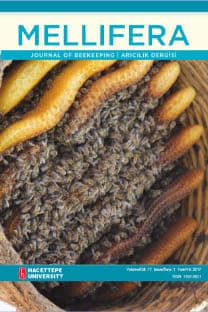Micromorphological Characters of Pollen, Leaflet and Seed of Astragalus victoriae and Astragalus melanophrurius Endemic to Turkey
Micromorphological Characters of Pollen, Leaflet and Seed of Astragalus victoriae and Astragalus melanophrurius Endemic to Turkey
In this study, palynological, seed and
leaflet micromorphological properties of Astragalus victoriae and Astragalus
melanophrurius species were investigated in detail using light
microscopy (LM) and scanning electron microscopy (SEM). The aim of this study
is to determine the contribution of pollen, leaflet and seed morphology
characters in distinguishing between these two closely related species. Study
results indicate that pollen of species are radial symmetric
and isopolar. Aperture type is trizonocolporate. Pollen
shape is determined as prolate-spheroidal
for Astragalus melanophrurius and subprolate for Astragalus victoriae. Ornamentation
type is observed as perforate at polar area and aperture surround, microreticulate at the other sides of
pollen for A. melanophrurius while ornamentation determined as
rugulate at polar area and aperture surround, microreticulate at the other sides of
pollen for Astragalus victoriae. Seeds shape are
reniform, the colour is light brown and surface ornamentation determined as
psilate in light microscope for both species while reticulate-rugulate with thin and irregular
muri determined in Astragalus victoriae and reticulate surface ornamentation with thick
and regular muri in Astragalus melanophrurius in SEM micrograph. Leaflet observed as elliptic-ovate, emarginated
with dens single celled trichomes on lower surface for A. melanophrurius while narrowly elliptic, apiculate,
with densely single-celled trichomes on lower surface leaflet observed for A.
victoriae. Trichomes have
scabrate ornamentation at A. melanophrurius and striate ornamentation at A. victoriae. On the lower surface of the leaflet
of A. victoriae 240 stomas and on the upper surface 263 stomas were
detected in 1 mm2. Wile on the lower surface of the leaflet of A.
melanophrurius 170 stomas and on the upper surface182 stomas were detected
in 1 mm2. According to results pollen shape, pollen surface ornamentation,
seed surface ornamentation, leaflet shape, trichome ornamentation, number of
stomata per 1 mm2 determined as important micromorphological
character for systematical delimination of two endemic species.
Keywords:
Astragalus pollen, leaflet, seed morphology,
___
[1] Legume Phylogeny Working Group (LPWG) (2013). Legume phylogeny and classification in the 21st century: progress, prospects and lessons for other species-rich clades. Taxon 62:217–248.[2] LEWIS, G; SCHRİRE, B; MACKİNDER, B; LOCK, M (2005). Legumes of the World. Royal Botanic Gardens, Kew.
[3] GÜNER, A; ASLAN, S; EKİM, T; VURAL, M; BABAÇ, M T (2012). Türkiye bitkileri Listesi (Damarlı Bitkiler). Nezahat Gökyiğit Botani Bahçesi ve Flora Araştırmaları Derneği Yayını, İstanbul.
[4] IUCN (2010). IUCN Standards and petitions subcommittee. Guidelines for Using the IUCN Red List Categories and Criteria. Version 8.1. Prepared by the Standards and Petitions Subcommittee. Gland, Switzerland: IUCN.
[5] PODLECH, D; ZARRE, S H (2013). A taxonomic revision of the genus Astragalus L. (Leguminosae) in the Old World. vols. 1–3. Naturhistorisches Museum, Wien, pp. 2439.
[6] BAYTOP, A; GÖZLER, T (1971). Türk kitre zamkının menşei ve terkibi hakkkında. İstanbul Eczacılık Fakültesi Dergisi, 7, 56-65.
[7] KOMEILI, A B; AMBROSE, J T (1990). Biology, ecology and damage of tracheal mites on honey bees (Apis mellifera). American Bee Journal 130: 193-199
[8] SIRALI, R; DEVECİ, M (2002). Investigation of the important Bee (Apis mellifera L.) plants in Thrace Region. Uludag Bee Journal 2(1):17-26,
[9] SORKUN, K (2008). Türkiye’nin nektarlı bitkileri, polenleri ve balları. Palme Yayınları 462. Ankara.337p.
[10] AKAN, H; TATLIDIL, S; BIÇAKÇI, A (2005). Pollen morphology of Astragalus L. Section Alopecuroidei DC. (Fabaceae) in Turkey. International Journal of Botany 1(1): 50-58.
[11] EKICI, M; YÜZBAŞIOĞLU, D; AYTAÇ, Z (2005). Morphology, pollen, seed structure and karyological study on Astragalus ovalis Boiss & Balansa (sect. Ammodendron) in Turkey. International Journal of Botany 1(1): 74-78.
[12] PINAR N M; EKICI, M; AYTAC, Z; AKAN, H; CETER; T; Alan, Ş (2009). Pollen morphology of Astragalus L. sect. Onobrychoidei DC. (Fabaceae) in Turkey. Turkish Journal of Botany 33: 291-303.
[13] CETER, T; EKICI, M; PINAR, NM; ÖZEK, F (2013). Pollen morphology of Astragalus L. section Hololeuce Bunge (Fabaceae) in Turkey. Acta Botanica Gallica 160(1): 43-52
[14] KARAMAN ERKUL, S; ÇETER, T; AYTAÇ, Z (2017). Türkiye'nin Astragalus L. (Leguminosae) cinsine ait Poterion Bunge seksiyonunun revizyonu. Ot Sistematik Botanik Dergisi, 24(1);1-20
[15] ÇETER, T; KARAMAN, S; AYTAÇ, Z; BAŞER, B (2013). Pollen morphology of Oxytropis DC. (Fabaceae) genus in Turkey. Bangladesh Journal of Botany 42(1): 167-174
[16] Wodehouse RR (1935). Pollen Grains, New York: McGraw-Hill. Wodehouse RR (1935). Pollen Grains, New York: McGraw-Hill.
- ISSN: 1302-5821
- Başlangıç: 2001
- Yayıncı: Hacettepe Üniversitesi
Sayıdaki Diğer Makaleler
Çiğdem ÖZENİRLER, Ömür Gençay ÇELEMLİ, Nazlı MAYDA, Kadriye SORKUN
Kethula MAMATHA, Ravula DEVENDER, Jangam Ganga KAILASH, Sonte NIRANJA, Hari RAMAKRISHNA
Harun METİN, Talip ÇETER, Seher KARAMAN ERKUL
Kethula MAMATHA, Ravula DEVENDER, Jangam Ganga KAILASH, Sonte NIRANJA, Hari RAMAKRISHNA
Importance of Nutrition for Honey Bee Health
Harun METİN, Talip ÇETER, Seher KARAMAN ERKUL
A New Record for Propolis Substitute: Pruning Sealer
Çiğdem ÖZENİRLER, Ömür Gençay ÇELEMLİ, Nazlı MAYDA, Kadriye SORKUN
